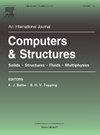Rare event probability evaluation for static and dynamic structures based on direct probability integral method
IF 4.4
2区 工程技术
Q1 COMPUTER SCIENCE, INTERDISCIPLINARY APPLICATIONS
引用次数: 0
Abstract
Efficient and accurate evaluation of the rare event probability is a crucial yet challenging task for the design of static and dynamic structures with uncertainties. This study establishes a novel level-wise representative points increment strategy for direct probability integral method (DPIM), which calculates accurately rare event probabilities (less than 10−3). Firstly, the two advantages of partitioning the probability space in DPIM, namely, enhanced accuracy in reliability estimation and flexibility in selecting representative points, are elaborated. Secondly, it is clarified that the error in reliability assessment using DPIM is caused by the imprecise simulation of important subdomains. The idea of increasing the number of important points is advanced to improve the precision of reliability assessment. Subsequently, inspired by subset simulation, the level-wise representative points increment strategy is proposed. This strategy effectively adds representative points within important subdomains by selecting new points from the low-level points. Embedding the points increment strategy into DPIM forms a unified and efficient method for rare event estimations of static and dynamic structures. Finally, the accuracy and efficiency of the proposed method are demonstrated in three typical examples by comparing with Monte Carlo simulation (MCS), Quasi-MCS and subset simulation. The results indicate that the proposed strategy significantly improves the accuracy of reliability assessment employing DPIM, and fulfils a versatile and precise analysis of rare event probabilities in both static and dynamic systems.
基于直接概率积分法的静、动结构罕见事件概率评估
对于具有不确定性的静、动结构设计而言,有效、准确地评估罕见事件概率是一项至关重要且具有挑战性的任务。本文建立了一种新的直接概率积分法(DPIM)的分层代表点增量策略,该策略可以准确地计算罕见事件的概率(小于10−3)。首先,阐述了DPIM中概率空间划分的两个优点,即可靠性估计精度的提高和代表性点选择的灵活性。其次,明确了DPIM可靠性评估的误差是由于对重要子域的模拟不精确造成的。为了提高可靠性评估的精度,提出了增加关键点数量的思想。随后,在子集仿真的启发下,提出了分层代表点增量策略。该策略通过从低层次点中选择新的点,有效地增加了重要子域内的代表性点。将点增量策略嵌入到DPIM中,形成了一种统一有效的静态和动态结构罕见事件估计方法。最后,通过与蒙特卡罗仿真(MCS)、拟MCS和子集仿真的比较,验证了该方法的准确性和有效性。结果表明,该策略显著提高了采用DPIM进行可靠性评估的准确性,并实现了静态和动态系统罕见事件概率的通用和精确分析。
本文章由计算机程序翻译,如有差异,请以英文原文为准。
求助全文
约1分钟内获得全文
求助全文
来源期刊

Computers & Structures
工程技术-工程:土木
CiteScore
8.80
自引率
6.40%
发文量
122
审稿时长
33 days
期刊介绍:
Computers & Structures publishes advances in the development and use of computational methods for the solution of problems in engineering and the sciences. The range of appropriate contributions is wide, and includes papers on establishing appropriate mathematical models and their numerical solution in all areas of mechanics. The journal also includes articles that present a substantial review of a field in the topics of the journal.
 求助内容:
求助内容: 应助结果提醒方式:
应助结果提醒方式:


